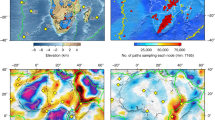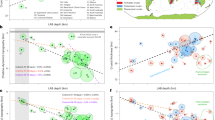Abstract
How cratons—extremely stable continental areas of the Earth’s crust—formed and remained largely unchanged for more than 2,500 million years is much debated. Recent studies of seismic-wave receiver function data have detected a structural boundary under continental cratons at depths too shallow to be consistent with the lithosphere–asthenosphere boundary, as inferred from seismic tomography and other geophysical studies. Here we show that changes in the direction of azimuthal anisotropy with depth reveal the presence of two distinct lithospheric layers throughout the stable part of the North American continent. The top layer is thick (∼150 km) under the Archaean core and tapers out on the surrounding Palaeozoic borders. Its thickness variations follow those of a highly depleted layer inferred from thermo-barometric analysis of xenoliths. The lithosphere–asthenosphere boundary is relatively flat (ranging from 180 to 240 km in depth), in agreement with the presence of a thermal conductive root that subsequently formed around the depleted chemical layer. Our findings tie together seismological, geochemical and geodynamical studies of the cratonic lithosphere in North America. They also suggest that the horizon detected in receiver function studies probably corresponds to the sharp mid-lithospheric boundary rather than to the more gradual lithosphere–asthenosphere boundary.
This is a preview of subscription content, access via your institution
Access options
Subscribe to this journal
Receive 51 print issues and online access
$199.00 per year
only $3.90 per issue
Buy this article
- Purchase on Springer Link
- Instant access to full article PDF
Prices may be subject to local taxes which are calculated during checkout





Similar content being viewed by others
References
Hoffman, P. F. United plates of America. The birth of a craton: early proterozoic assembly and growth of Laurentia. Annu. Rev. Earth Planet. Sci. 16, 543–603 (1988)
Haggerty, S. E. A diamond trilogy: superplumes, supercontinents, and supernovae. Science 285, 851–860 (1999)
Gung, Y., Panning, M. & Romanowicz, B. Global anisotropy and the thickness of continents. Nature 422, 707–711 (2003)
Mareschal, J. C. & Jaupart, C. Variations of surface heat flow and lithospheric thermal structure beneath the North American craton. Earth Planet. Sci. Lett. 223, 65–77 (2004)
Shapiro, S. S., Hager, B. H. & Jordan, T. H. The continental tectosphere and Earth’s long-wavelength gravity field. Lithos 48, 135–152 (1999)
Carlson, R. W., Pearson, D. G. & James, D. E. Physical, chemical, and chronological characteristics of continental mantle. Rev. Geophys. 43 10.1029/2004rg000156 (2005)
Jordan, T. H. Composition and development of the continental tectosphere. Nature 274, 544–548 (1978)
King, S. D. Archean cratons and mantle dynamics. Earth Planet. Sci. Lett. 234, 1–14 (2005)
Sleep, N. H. Survival of Archean cratonal lithosphere. J. Geophys. Res. 108 10.1029/2001jb000169 (2003)
Cooper, C. M., Lenardic, A. & Moresi, L. The thermal structure of stable continental lithosphere within a dynamic mantle. Earth Planet. Sci. Lett. 222, 807–817 (2004)
Lenardic, A., Moresi, L. & Mühlhaus, H. The role of mobile belts for the longevity of deep cratonic lithosphere: the crumple zone model. Geophys. Res. Lett. 27 10.1029/1999gl008410 (2000)
Lee, C. T. in Archean Geodynamics and Environments (eds Benn, K. Mareschal, J. C. & Condie, K. C.) 89–114 (American Geophysical Union Monograph, 2006)
Griffin, W. L. et al. Lithosphere mapping beneath the North American plate. Lithos 77, 873–922 (2004)
Jones, A. G. et al. The electrical structure of the Slave craton. Lithos 71, 505–527 (2003)
Rychert, C. A. & Shearer, P. M. A global view of the lithosphere-asthenosphere boundary. Science 324, 495–498 (2009)
Abt, D. et al. North American lithospheric discontinuity structure imaged by Ps and Sp receiver functions. J. Geophys. Res. 10.1029/2009JB006710 (in the press)
Yuan, X., Kind, R., Xueqing, L. & Rongjiang, W. The S receiver functions: synthetics and data example. Geophys. J. Int. 165, 555–564 (2006)
Romanowicz, B. The thickness of tectonic plates. Science 324, 474–476 (2009)
Thybo, H. & Perchuc, E. The seismic 8° discontinuity and partial melting in continental mantle. Science 275, 1626–1629 (1997)
Levin, V., Menke, W. & Park, J. Shear wave splitting in the Appalachians and the Urals; a case for multilayered anisotropy. J. Geophys. Res. 104, 17975–17994 (1999)
Deschamps, F., Lebedev, S., Meier, T. & Trampert, J. Stratified seismic anisotropy reveals past and present deformation beneath the East-central United States. Earth Planet. Sci. Lett. 274, 489–498 (2008)
Griffin, W. L. et al. The origin and evolution of Archean lithospheric mantle. Precambr. Res. 127, 19–41 (2003)
Canil, D. Canada's craton: a bottom's-up view. GSA Today 18, 4–11 (2008)
Babuska, V. & Cara, M. Seismic Anisotropy in the Earth Ch. 5 (Kluwer Academic, 1991)
Marone, F. & Romanowicz, B. The depth distribution of azimuthal anisotropy in the continental upper mantle. Nature 447, 198–201 (2007)
Gripp, A. E. & Gordon, R. G. Young tracks of hotspots and current plate velocities. Geophys. J. Int. 150, 321–361 (2002)
Yuan, H. & Romanowicz, B. Depth dependent azimuthal anisotropy in the western US upper mantle. Earth Planet. Sci. Lett. (submitted)
Whitmeyer, S. J. & Karlstrom, K. E. Tectonic model for the Proterozoic growth of North America. Geosphere 3, 220–259 (2007)
Percival, J. A. et al. Tectonic evolution of the western Superior Province from NATMAP and Lithoprobe studies. Can. J. Earth Sci. 43 10.1139/E1106-1062 (2006)
van der Velden, A. J. & Cook, F. A. Relict subduction zones in Canada. J. Geophys. Res. 110 10.1029/2004jb003333 (2005)
Bostock, M. G. Mantle stratigraphy and evolution of the Slave Province. J. Geophys. Res. 103, 21183–21200 (1998)
Yuan, H. & Dueker, K. in The Rocky Mountain Region—An Evolving Lithosphere: Tectonics, Geochemistry, and Geophysics (eds Randy, G. & Karlstrom, K. E.) Geophysical monograph 154, 329–345 (American Geophysical Union, 2005)
Silver, P. G. & Chan, W. W. Shear wave splitting and subcontinental mantle deformation. J. Geophys. Res. 96, 16429–16454 (1991)
Vinnik, L. P., Makeyeva, L. I., Milev, A. & Usenko, A. Y. Global patterns of azimuthal anisotropy and deformations in the continental mantle. Geophys. J. Int. 111, 433–447 (1992)
St-Onge, M. R., Wodicka, N. & Ijewliw, O. Polymetamorphic evolution of the Trans-Hudson orogen, Baffin Island, Canada: integration of petrological, structural and geochronological data. J. Petrol. 48, 271–302 (2007)
Culotta, R. C., Pratt, T. & Oliver, J. A tale of two sutures: COCORP's deep seismic surveys of the Grenville province in the eastern U.S. midcontinent. Geology 18, 646–649 (1990)
Snyder, D. B. Lithospheric growth at margins of cratons. Tectonophysics 355, 7–22 (2002)
Montagner, J.-P. & Nataf, H.-C. Vectorial tomography. I. Theory. Geophys. J. 94, 295–307 (1988)
Marone, F., Gung, Y. & Romanowicz, B. Three-dimensional radial anisotropic structure of the North American upper mantle from inversion of surface waveform data. Geophys. J. Int. 171, 206–222 (2007)
Plomerová, J. & Babuska, V. Long memory of mantle lithosphere fabric—European LAB constrained from seismic anisotropy. Lithos 10.1016/j.lithos.2010.1001.1008 (in the press)
Li, A., Fischer, K. M., Wysession, M. E. & Clarke, T. J. Mantle discontinuities and temperature under the North American continental keel. Nature 395, 160–163 (1998)
Darbyshire, F. A. & Lebedev, S. Rayleigh wave phase-velocity heterogeneity and multilayered azimuthal anisotropy of the Superior Craton, Ontario. Geophys. J. Int. 176, 215–234 (2009)
Li, A., Forsyth, D. W. & Fischer, K. M. Shear velocity structure and azimuthal anisotropy beneath eastern North America from Rayleigh wave inversion. J. Geophys. Res. 108 10.1029/2002JB002259 (2003)
Long, M. D. & Silver, P. G. The subduction zone flow field from seismic anisotropy: a global view. Science 319, 315–318 (2008)
Arndt, N. T., Coltice, N., Helmstaedt, H. & Gregoire, M. Origin of Archean subcontinental lithospheric mantle: some petrological constraints. Lithos 109, 61–71 (2009)
Mierdel, K., Keppler, H., Smyth, J. R. & Langenhorst, F. Water solubility in aluminous orthopyroxene and the origin of Earth’s asthenosphere. Science 315, 364–368 (2007)
Sleep, N. H. Stagnant lid convection and carbonate metasomatism of the deep continental lithosphere. Geochem. Geophys. Geosyst. 10 10.1029/2009gc002702 (2009)
Rychert, C. A., Fischer, K. M. & Rondenay, S. A sharp lithosphere–asthenosphere boundary imaged beneath eastern North America. Nature 436, 542–545 (2005)
Lekic, V. & Romanowicz, B. A simple method for improving crustal corrections in waveform tomography. Geophys. J. Int. 182, 265–278 (2010)
Montagner, J.-P., Griot-Pommera, D.-A. & Lave, J. How to relate body wave and surface wave anisotropy? J. Geophys. Res. 105, 19015–19027 (2000)
Li, X.-D. & Romanowicz, B. Comparison of global waveform inversions with and without considering cross-branch modal coupling. Geophys. J. Int. 121, 695–709 (1995)
Montagner, J.-P. & Nataf, H.-C. A simple method for inverting the azimuthal anisotropy of surface waves. J. Geophys. Res. 91, 511–520 (1986)
Panning, M. & Romanowicz, B. A three-dimensional radially anisotropic model of shear velocity in the whole mantle. Geophys. J. Int. 167, 361–379 (2006)
Montagner, J.-P. & Anderson, D. L. Petrological constraints on seismic anisotropy. Phys. Earth Planet. Inter. 54, 82–105 (1989)
Mégnin, C. & Romanowicz, B. The three-dimensional shear velocity structure of the mantle from the inversion of body, surface and higher-mode waveforms. Geophys. J. Int. 143, 709–728 (2000)
Lekic, V. Inferring the Elastic Structure of the Mantle using the Spectral Element Method PhD thesis, University of California (2009)
Tarantola, A. & Valette, B. Generalized nonlinear inverse problems solved using the least squares criterion. Rev. Geophys. Space Phys. 20, 219–232 (1982)
Yuan, H., Romanowicz, B., Fisher, K. & Abt, D. 3-D shear wave radially and azimuthally anisotropic velocity model of the North American upper mantle. Geophys. J. Int. (submitted)
Acknowledgements
We thank the IRIS Data Management Center, the Geological Survey of Canada and the Northern California Earthquake Data Center for providing the waveform data used in this study. Discussion with K. Fischer helped improve the manuscript. We thank K. Liu, R. Allen, M. Fouch, A. Frederiksen and A. Courtier for providing their SKS compilations, and W. Griffin and S. O’Reilly for their North American olivine composition measurements. This study was supported by a grant from the National Science Foundation/EarthScope programme. This is the Berkeley Seismological Laboratory contribution number 10-08.
Author information
Authors and Affiliations
Contributions
B.R. developed the concept and methodology of the study. H.Y. assembled the data set, and performed the inversions and the supporting resolution tests. Both authors extensively discussed the results and jointly developed implications. Both authors contributed to writing the paper.
Corresponding author
Ethics declarations
Competing interests
The authors declare no competing financial interests.
Supplementary information
Supplementary Information
This file contains Supplementary Information 1 - 2, References and Supplementary Figures 1 - 12 with legends. (PDF 4938 kb)
Rights and permissions
About this article
Cite this article
Yuan, H., Romanowicz, B. Lithospheric layering in the North American craton. Nature 466, 1063–1068 (2010). https://doi.org/10.1038/nature09332
Received:
Accepted:
Issue Date:
DOI: https://doi.org/10.1038/nature09332
This article is cited by
-
Secular craton evolution due to cyclic deformation of underlying dense mantle lithosphere
Nature Geoscience (2023)
-
Short-scale laterally varying SK(K)S shear wave splitting at BFO, Germany — implications for the determination of anisotropic structures
Journal of Seismology (2022)
-
Rheological inheritance controls the formation of segmented rifted margins in cratonic lithosphere
Nature Communications (2021)
-
Quasi-Love wave scattering reveals tectonic history of Australia and its margins reflected by mantle anisotropy
Communications Earth & Environment (2021)
-
Lithospheric thermal and compositional structure of South China jointly inverted from multiple geophysical observations
Science China Earth Sciences (2021)
Comments
By submitting a comment you agree to abide by our Terms and Community Guidelines. If you find something abusive or that does not comply with our terms or guidelines please flag it as inappropriate.



